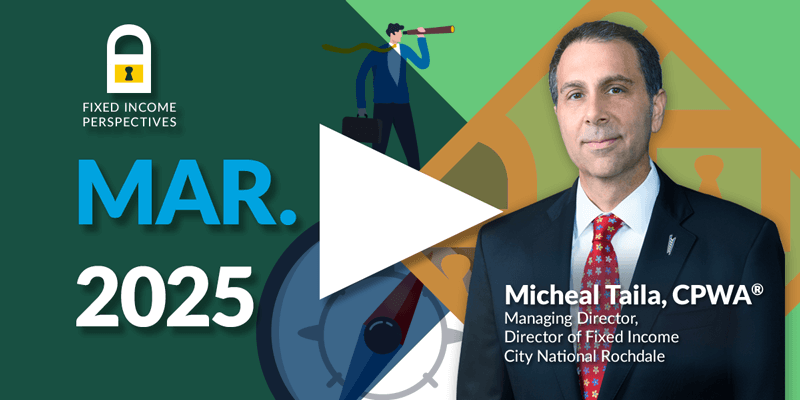
Trade War Redux: The Economic and Market Impact of New U.S. Tariffs

The Rundown
- Tariff Hike Impact: President Trump's "Liberation Day" raises the effective U.S. tariff rate to approximately 19%, the highest since 1930, with reciprocal tariffs resulting in a weighted average increase of 18.3% (12.6% when adjusted for exclusions).1
- Asian Trade Hit Hard: China faces a 34% tariff hike (bringing overall rates to north of 60%), signaling a direct effort to target Chinese U.S. imports. Other Asian countries, especially Vietnam, Taiwan, Thailand and Indonesia, are also seeing major increases. 1
- Market Reaction: Equity markets sold off sharply (S&P -4.83%, Nasdaq -5.96%, Dow -4.30%), volatility spiked and yields dropped, while market-based Fed rate cut expectations increased to four cuts this year. 1
- Economic Risks Rising: We estimate that tariffs could drag U.S. GDP down by 1.0% or more and push inflation up between 1.0% and 1.5%, raising the risk of recession primarily due to consumer and business confidence. 1
- Global Repercussions & Retaliation: China has launched 34% tariffs on all U.S. imports and Europe has vowed to take action, but excessive retaliation could worsen the situation; exemptions and negotiations may ease pressures in Q2.1
President Trump's "Liberation Day" will result in a weighted average tariff rate increase of 18.3%, exceeding expectations prior to the April 2 announcement. However, the effective increase from reciprocal tariffs when accounting for product exclusions and existing tariffs is approximately 12.6%. Overall, the effective U.S. tariff rate, including all YTD tariffs is approximately 19%, which is the highest since the Smoot-Hawley Tariff Act of 1930 (19.8%). While most tariff rates moved higher, the order continues to exempt USMCA-compliant imports from Canada and Mexico and notes that if this exemption ends, noncompliant products will face a tariff of 12%, indicating a potential upper bound on North American tariff rates. Asian countries fared the worst. China is facing a 34% increase, bringing its overall effective tariff rate to over 60% (when including the impact of the elimination of the de minimis threshold) and Vietnam (46%), Taiwan (36%), Thailand (36%) and Indonesia (32%) are facing significant levies.2 We believe that the main focus of tariff policy is to cripple China as widespread hikes arrest any effort to circumvent direct trade. Early estimates indicate that exports to the U.S. from China could drop 80% and result in a 1.0%-2.0% drag on Chinese growth, coming at a time when the Chinese economy is fragile.2 While we expect to see a large boost in Chinese fiscal and monetary policy, which will likely create interim rallies, we continue to see downside to a long-term investment in China. Despite the potential shock to global growth, U.S. Treasury Secretary Scott Bessent described the announced tariffs as a ceiling, suggesting that levies could be rolled back.
On Thursday, the S&P500 fell 4.83%, while the Nasdaq and the Dow dropped 5.96% and 4.30%, respectively.3 Alongside equity markets, yields fell with drops of 7-12 bps in U.S. Treasuries.4 The 10-year treasury yield is down 53 bps this year.3 Volatility measures have jumped indicating significant stress and the movement in rates alongside changes in the currency markets, gold, oil and broader commodities suggests that the market reaction is squarely focused on the impact to global growth.3 Early on, Federal Reserve target rate expectations moved very little.3 However, the implied rate for December now signals four rate cuts, which we believe will be difficult facing the potential for higher inflation.3
So, while the levels of absolute stress aren't catastrophic, the combined effect of yesterday’s drop and Friday’s downward momentum does not bode well for equity returns in the near term. The S&P closed below the previous March low, which is likely to keep the equity market under pressure. Given the sheer magnitude of reciprocal tariffs, it looks like the impact to inflation and growth will be above the higher end of the ranges discussed in our March 27 webinar. GDP growth could be impacted by more than -1.0% and inflation could climb an additional 1.5%.
Given these changes to the outlook, we believe the following three questions are important.
- First, can the economy bear this level of tariffs without dipping into a recession?
- Second, will this spur countries to more aggressively pursue exemptions?
- Third, what will the level of global retaliation be?
Can the economy bear this level of tariffs without dipping into a recession?
It's clear that the probability of a recession has increased, not because of fundamental deterioration, but due to expectations. The U.S. is going to face a period of inflationary pressure, and businesses are likely to delay investment and hire less. Consumers may save more and spend less. The key to the first question is longevity. While we believe the potential is there for negotiations to result in more exemptions, the longer tariffs stay at these levels, the higher the probability of negative growth. So, we are not hurtling toward a recession, but ongoing tariff negotiations and other policy measures, such as deregulation and tax policy, must be large enough to partially offset increased tariffs. The events of this week have the potential to mark "peak tension," but only if the tariffs scale down from here.
Will this spur countries to more aggressively pursue exemptions?
The U.S. is the largest export market in the world. With a 20% tariff on most developed nations, the dependence of the global trade system on the U.S. will result in significant strain in many countries, especially the emerging world. We are seeing preliminary estimates that Eurozone growth may stumble by as much as 2%, taking most European countries into negative GDP territory.4 Asia will also face a significant threat to growth. While it does not appear likely that the Trump administration will back down without significant concessions, unwavering commitment to tariffs may produce negotiations that result in a full trade policy reset with many nations. That implies that policy could improve from here, which complicates our risk positioning. If the market remains somewhat stable and trading orderly, de-risking in this environment will require perfect timing. With sentiment levels at extreme pessimism (market and survey based) and the potential for countries to pursue exemptions coupled with price pressures that could result in negative bond returns, we believe the best route is to stay invested in the equity market. As the global situation unfolds and we consider changes to asset allocation, there may be a place for changing our geographical mix and adjusting the overall level of equity exposure. Once the dust settles, a reevaluation of valuations and structural economic considerations will drive any change.
What will the level of global retaliation be?
Last, while China has announced a 34% tariff on U.S. imports, understanding and gaining clarity around further levels of retaliation is important. Facing major shocks to growth, strong retaliation may not be in the best interest of many countries. However, we cannot count on other countries to have a steady hand, facing what is likely to appear externally as raw aggression from the U.S. While it is impossible at this point to predict the retaliatory impacts, it will be key in assessing the economic impact going forward.
Conclusion
The tariff escalation marks a significant shift in U.S. trade policy, with broad implications for markets, inflation and global growth. While short-term volatility and heightened uncertainty are real, it's important to view these developments in the context of longer-term economic fundamentals and policy responses. Market pullbacks, rising rate cut expectations, and signs of global retaliation may dominate headlines, but they also open the door to renewed negotiations, potential exemptions and eventual policy recalibration. As global dynamics evolve, staying grounded in long-term investment discipline—rather than reacting to short-term disruptions—will be key to navigating this period of adjustment with clarity and resilience.
1Goldman Sachs, USA: President Trump Announces “Reciprocal” Tariffs, as of April 2, 2025
2Bloomberg, China Vows Retaliation as Trump Unleashes ‘Bazooka’ US Tariffs, as of April 2, 2025
3Bloomberg, as of April 2, 2025
4Bloomberg, EUROPE PREVIEW: Trump Gripes May Mean 50% Tariff, 2% GDP Hit (1), as of April 2, 2025
Important Information
The views expressed represent the opinions of City National Rochdale, LLC (CNR) which are subject to change and are not intended as a forecast or guarantee of future results. Stated information is provided for informational purposes only, and should not be perceived as personalized investment, financial, legal or tax advice or a recommendation for any security. It is derived from proprietary and non-proprietary sources which have not been independently verified for accuracy or completeness. While CNR believes the information to be accurate and reliable, we do not claim or have responsibility for its completeness, accuracy, or reliability. Statements of future expectations, estimates, projections, and other forward-looking statements are based on available information and management's view as of the time of these statements. Accordingly, such statements are inherently speculative as they are based-on assumptions which may involve known and unknown risks and uncertainties. Actual results, performance or events may differ materially from those expressed or implied in such statements.
All investing is subject to risk, including the possible loss of the money you invest. As with any investment strategy, there is no guarantee that investment objectives will be met, and investors may lose money. Diversification may not protect against market risk or loss. Past performance is no guarantee of future performance.
There are inherent risks with equity investing. These risks include, but are not limited to stock market, manager, or investment style. Stock markets tend to move in cycles, with periods of rising prices and periods of falling prices.
City National Rochdale, LLC is an SEC-registered investment adviser and wholly-owned subsidiary of City National Bank. Registration as an investment adviser does not imply any level of skill or expertise. City National Bank is a subsidiary of the Royal Bank of Canada.
Index Definitions
The Standard and Poor’s 500® Index (S&P 500) is a market capitalization-weighted index of 500 common stocks chosen for market size, liquidity, and industry group representation to represent U.S. equity performance.
The S&P 500 Futures Index is constructed from the front-quarter E-mini futures contract on the S&P 500. It is part of the S&P Factor Series, which measures the inherent risk premium between asset classes and financial markets.
The Nasdaq Composite Index is a market capitalization-weighted index of more than 2,500 stocks listed on the Nasdaq stock exchange.
The CBOE Volatility Index (VIX) is a real-time market index that represents the market’s expectations for volatility over the coming 30 days. Also known as the "fear index," it measures expected price fluctuations in the S&P 500 Index options and is used by investors to assess risk and market stress.
Indices are unmanaged and one cannot invest directly in an index. Index returns do not reflect a deduction for fees or expenses.
NON-DEPOSIT INVESTMENT PRODUCTS: • ARE NOT FDIC INSURED • ARE NOT BANK GUARANTEED • MAY LOSE VALUE
© 2025 City National Rochdale. All rights reserved.
Stay Informed.
Get our Insights delivered straight to your inbox.
Put our insights to work for you.
If you have a client with more than $1 million in investable assets and want to find out about the benefits of our intelligently personalized® portfolio management, speak with an investment consultant near you today.
If you’re a high-net-worth client who's interested in adding an experienced investment manager to your financial team, learn more about working with us here

